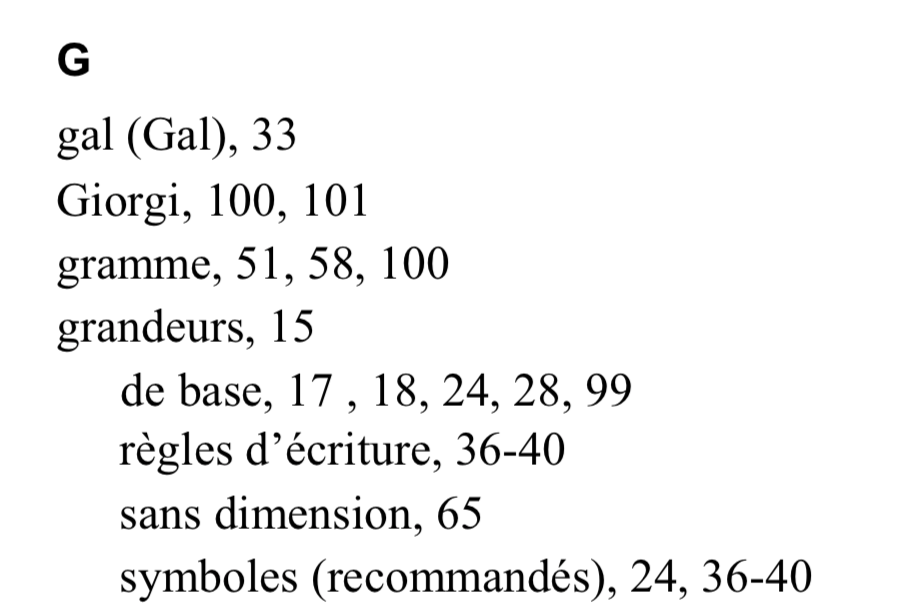Index terms
General
Metanorma supports index entries with primary, secondary and tertiary index terms. [added in https://github.com/metanorma/metanorma-standoc/releases/tag/v1.3.10].
Primary index terms are listed under the first-level index, the secondary index terms are listed under the primary index terms' sub-index, and the tertiary index terms are listed under the secondary index term’s sub-index.

Index term behavior differs per rendered output format:
-
In PDF, indexes are rendered as references to page numbers.
-
In HTML and DOC, indexes are rendered as references to the nearest labelled block; a note, example, figure, formula etc., if the index term is contained within it, or a clause or subclause, otherwise.
Index term links are only rendered in certain flavours, and do not appear otherwise in DOC, PDF or HTML output.
|
Note
|
Currently, only the ISO, IETF and BIPM flavours render index terms. |
|
Note
|
Metanorma always processes index terms and creates the corresponding XML. However, not all flavors render an "Index" section. Check out the flavor documentation for your SDO to see if it supports indexing. |
Getting started
Before you define an index term, your document needs a section where the index
terms can appear. To create an index, define a level 1 section (==) marked with
the style index at the end of your document.
[index]
== IndexIndex entries can consist of up to three levels using a comma to separate the terms.
Metanorma provides two options to create an index entry:
-
Visible index terms are words within the text that are annotated with an index entry using double parentheses.
((Level 1 index term)) -
Hidden index terms are index entries that are not visible in the final output and are generated using triple parentheses.
(((Level 1 index term, Level 2 index term, Level 3 index term))). These allow the index to include optional subterms and sub-subterms; they also allow the index term to differ from what actually appears in the text.
Let’s have a look at an example:
The Lady of the Lake, her arm clad in the purest shimmering samite,
held aloft Excalibur from the bosom of the water,
signifying by divine providence that I, ((Arthur)), (1)
was to carry Excalibur (((Sword, Broadsword, Excalibur))). (2)-
((Arthur))will be displayed asArthurin the text and carries a first level index entry -
(((Sword, Broadsword, Excalibur)))will not appear in the text, but a three level index entry will be generated.
Index placement
If any index terms are present in a document, and the current flavour supports indexes, then an index section will be automatically generated and appended to the end of the document.
To override the title of the index section, or indicate where it should be placed, use the index section markup shown below.
[index]
== IndexAny index will be appended after any content you may choose to place in the index section, but indexes typically appear with no preface.
Automated index terms
If the document attribute :index-terms: is used, all terms (and symbols) are
indexed automatically in postprocessing.
The document does not need to include explicit index terms for them [added in https://github.com/metanorma/metanorma-standoc/releases/tag/v1.11.3].
Rendered index term syntax
Metanorma index entries are entered through two different syntaxes. [added in https://github.com/metanorma/metanorma-standoc/releases/tag/v1.3.10].
Rendered index term: ((Term))
-
Produces the output “Term”; and
-
Links to the primary index term of the same name, “Term”.
Hidden index term: (((IndexTerm1))),
(((IndexTerm1, IndexTerm2))) or
(((IndexTerm1, IndexTerm2, IndexTerm3)))
-
Produces no output; and
-
Links to the primary index term
IndexTerm1. And if provided, links to the secondary nesting,IndexTerm2and the tertiary nestingIndexTerm3.
The Lady of the Lake, her arm clad in the purest shimmering samite,
held aloft Excalibur from the bosom of the water,
signifying by divine providence that I, ((Arthur)),
was to carry Excalibur (((Sword, Broadsword, Excalibur))).Rich-text formatting in index terms
Rich-text formatting in index terms is supported [added in https://github.com/metanorma/metanorma-standoc/releases/tag/v1.7.0].
signifying by divine providence that I, ((*Arthur*)),
was to carry Excalibur (((Sword~E~, stem:[sqrt(E)], Excalibur))).|
Note
|
Formatting of index terms is ignored in IETF rendering. |
Entry ranges
Metanorma supports index entries that involve
ranges [added in https://github.com/metanorma/metanorma-standoc/releases/tag/v1.7.0],
using the command index-range:to[…].
The command itself accepts an AsciiDoc index entry, such as
((...)) or (((...))).
The index entry range starts at the location of the index-range
command, in the same way as the index command it contains; the end of
the range is the element with the anchor to, and that is expected
to be provided as a bookmark.
signifying by divine providence that I, index-range:end-range-1[((*Arthur*))],
was to carry Excalibur index-range:end-range-2[(((Sword~A~, stem:[sqrt(2)], Excalibur)))].
...
and so forth.[[end-range-1]]
...
_Sic explicit fabula._[[end-range-2]]The preceding example has a visible index entry for Arthur,
ranging from the location of *Arthur* up to end-range-1, and
a hidden index entry for SwordA, ranging from the location of
Sword~A~ up to end-range-2.
Cross-references
Metanorma also supports “see” and “see also” cross-references between
index terms [added in https://github.com/metanorma/metanorma-standoc/releases/tag/v1.6.5],
using the index command.
The command takes at least two parameters:
-
the primary index term to be cross-referenced;
-
the target of the cross-reference;
-
optionally, the secondary and tertiary index term to be cross-referenced.
index:see[Satchmo,Louis Armstrong]
index:see[James Brown,influences,Hank Ballard and the Midnighters]
index:also[guitar,electric,technique,Jimi Hendrix]Rendered as:
Satchmo, see Louis Armstrong
James Brown
influences, see Hank Ballard and the Midnighters
guitar
electric
technique, see also Jimi Hendrix